Comparison of the Conventional Approach and Augmented Reality on the Purchase and Selection of Food Products
Abstract
:1. Introduction
- examine the influence of basic features on packaging, and its promotion, on the decision to purchase a food product (Packaging appearance, quality of packaging, origin of the product, product price, Brand preference, advertising of a food product, product placement on shelves).
- determine the motivational factor which most affects the purchase of food products offered to the respondents via analog media (brand, Habitual buying, Packaging appearance and dominant color).
- compare a conventional approach of presenting a chocolate product using printed packaging against the approach that uses the application of augmented reality and digital technology.
2. Methodology and Experiment
2.1. Instrument Design—Questionnaire
2.2. Instrument Design—Analog Visuals
2.3. Instrument Design—Digital Visuals
2.4. Sample Evaluation
3. Results and Discussion
3.1. Analysis of Factors Influencing the Purchase of Food Products
3.2. Comparison of Chocolate Choices on Analog and Digital Media
3.2.1. Analysis of Factors Influencing the Choice of Chocolate on Analog and Digital Media
3.2.2. Comparison of Motivational Factors on Different Media Using the Correlation Analysis
4. Conclusions
Author Contributions
Funding
Institutional Review Board Statement
Informed Consent Statement
Conflicts of Interest
Appendix A
| Survey: The impact of packaging and ICT on the selection and purchase of food products | |||||
| Gender: | M | F | |||
| Age: | 18–20 | 21–23 | 24–26 | 27+ | |
| Favorite color: | ________________ | ||||
| Read the text of the questionnaire carefully. Choose from 1 to 5 the impact of individual factors on the selection and purchase of food: PART ONE OF THE SURVEY | |||||
| (1 = Strongly disagree… 5 = Strongly agree) | |||||
| 1. Packaging appearance affects the choice and purchase of a food product. | |||||
| 1 | 2 | 3 | 4 | 5 | |
| 2. Quality packaging is a guarantee of a quality food product. | |||||
| 1 | 2 | 3 | 4 | 5 | |
| 3. Croatian origin of the product influences the selection and purchase of a food product. | |||||
| 1 | 2 | 3 | 4 | 5 | |
| 4. The price of the product affects the selection and purchase of the food product. | |||||
| 1 | 2 | 3 | 4 | 5 | |
| 5. Brand preference influences the choice and purchase of a food product. | |||||
| 1 | 2 | 3 | 4 | 5 | |
| 6. Advertising a food product affects its selection and purchase. | |||||
| 1 | 2 | 3 | 4 | 5 | |
| 7. Product Position/Placement on shelves influences the selection and purchase of a food product. | |||||
| 1 | 2 | 3 | 4 | 5 | |
| 8. Which information on the food packaging do you pay the most attention to? | |||||
| (select and rank 3 answers from those offered) |  | ||||
| (a) List of ingredients and application method | |||||
| (b) Date of manufacture and expiry date | |||||
| (c) Name of the food product | |||||
| (d) Food manufacturer | |||||
| (e) Country of origin | |||||
| 9. According to you, what is the deciding factor for choosing and buying a food product? (select and rank 3 answers from those offered) | |||||
| (a) Packaging appearance |  | ||||
| (b) Product quality | |||||
| (c) Origin of products | |||||
| (d) Product price | |||||
| (e) Product brand | |||||
| PART TWO OF THE SURVEY | |||||
| SEE THE PICTURE ATTACHED: 8 TYPES OF CHOCOLATE | |||||
| 10. Which 3 types of chocolates would you buy? | |||||
| (select and rank only 3 products from the attached image) | |||||
| (a) Fin Carre |  | ||||
| (b) Lindt | |||||
| (c) Zvečevo Mikado | |||||
| (d) Dairy Milk | |||||
| (e) Milka | |||||
| (f) Bellarom | |||||
| (g) Alpinella | |||||
| (h) Kraš Dorina | |||||
| 11. Which factor influence your previous choice of chocolates from the template the most? (select and rank 3 answers from those offered) | |||||
| (a) Color |  | ||||
| (b) Packaging appearance | |||||
| (c) Product brand | |||||
| (d) Habitual buying | |||||
| 12. What did you first notice on the product packaging? (select and rank 3 answers from those offered) | |||||
| (a) Submissive/background—dominant color |  | ||||
| (b) Graphics (picture, illustration) | |||||
| (c) Product brand name | |||||
| (d) Manufacturer’s logo | |||||
| SEE THE CONTENT GENERATED ON THE TABLET: 8 TYPES OF CHOCOLATE | |||||
| 13. Which 3 chocolates would you buy based on tablet display? | |||||
| (select and rank only 3 products according to tablet display) | |||||
| (a) Fin Carre |  | ||||
| (b) Lindt | |||||
| (c) Zvečevo Mikado | |||||
| (d) Dairy Milk | |||||
| (e) Milka | |||||
| (f) Bellarom | |||||
| (g) Alpinella | |||||
| (h) Kraš Dorina | |||||
| 14. Which factor influenced the most your choice of product, based on the tablet display? (select and rank 3 answers from those offered) | |||||
| (a) Display technology |  | ||||
| (b) Interactivity | |||||
| (c) Color | |||||
| (d) Packaging appearance | |||||
| (e) Product brand | |||||
| (f) Habitual buying | |||||
| PART THREE OF THE SURVEY | |||||
| SEE THE PICTURE ATTACHED: PASTA | |||||
| 15. Which underlying color is the most acceptable for pasta packaging? (select and rank only 3 products from the attached image) | |||||
| (a) green |  | ||||
| (b) yellow | |||||
| (c) red | |||||
| (d) gray | |||||
| (e) blue | |||||
| (f) pink | |||||
| (g) orange | |||||
| (h) purple | |||||
| SEE THE PICTURE ATTACHED: CHOCOLATE | |||||
| 16. Which is the most acceptable underlying color for chocolate packaging? | |||||
| (select and rank only 3 products from the attached image) | |||||
| (a) green |  | ||||
| (b) yellow | |||||
| (c) red | |||||
| (d) gray | |||||
| (e) blue | |||||
| (f) pink | |||||
| (g) orange | |||||
| (h) purple | |||||
References
- Ampuero, O.; Vila, N. Consumer perceptions of product packaging. J. Consum. Mark. 2006, 23, 100–112. [Google Scholar] [CrossRef]
- Smith, P.R.; Taylor, J. Marketing Communications: An Integrated Approach; Kogan Page Publishers: London, UK, 2004. [Google Scholar]
- Vila, N.; Ampuero, O. The role of packaging in positioning an orange juice. J. Food Prod. Mark. 2007, 13, 21–48. [Google Scholar] [CrossRef]
- Rettie, R.; Brewer, C. The verbal and visual components of package design. J. Prod. Brand Manag. 2000, 9, 56–70. [Google Scholar] [CrossRef] [Green Version]
- Silayoi, P.; Speece, M. Packaging and purchase decisions: An exploratory study on the impact of involvement level and time pressure. Br. Food J. 2004, 106, 607–628. [Google Scholar] [CrossRef]
- Agariya, A.K.; Johari, A.; Sharma, H.K.; Chandraul, U.; Singh, D. The role of packaging in brand communication. Int. J. Sci. Eng. Res. 2012, 3, 1–13. [Google Scholar]
- Underwood, R.L.; Klein, N.M. Packaging as brand communication: Effects of product pictures on consumer responses to the package and brand. J. Mark. Theory Pract. 2002, 10, 58–68. [Google Scholar] [CrossRef]
- Rundh, B. The role of packaging within marketing and value creation. Br. Food J. 2016, 118, 2491–2511. [Google Scholar] [CrossRef]
- Underwood, R.L. The communicative power of product packaging: Creating brand identity via lived and mediated experience. J. Mark. Theory Pract. 2003, 11, 62–76. [Google Scholar] [CrossRef]
- Wu, A. Food packaging design and its application in the brand marketing. Carpathian J. Food Sci. Technol. 2015, 7, 5–15. [Google Scholar]
- Waheed, S.; Khan, M.M.; Ahmad, N. Elements of Packaging and Consumer Purchase Intention–A Case of Chocolate Buying Behavior. Market Forces 2018, 13, 97–114. [Google Scholar]
- Baghestani Rad, A.; Ghouchani, F.; Mohtashami, A. A Study of the Effects of Packaging on the Increase of Sale of Foods Industry in Chocolate. Int. J. Adv. Stud. Humanit. Soc. Sci. 2016, 5, 300–308. [Google Scholar]
- Demo, G.; Coura, K.; Scussel, F.; Azevedo, G. How Do Brazilian Consumers Relate to Chocolate Brands? Validity and Reliability Evidence of the Chocolate Brands Relationship Scale. Sustainability 2021, 13, 5635. [Google Scholar] [CrossRef]
- Keller, K.L. Choosing brand elements to build brand equity. In Strategic Brand Management, 3rd ed.; Dorling Kindersley: Delhi, India, 2009; pp. 187–196. [Google Scholar]
- Kauppinen-Räisänen, H. Strategic use of colour in brand packaging. Packag. Technol. Sci. 2014, 27, 663–676. [Google Scholar] [CrossRef]
- Valdec, D.; Hajdek, K.; Majnarić, I.; Čerepinko, D. Influence of Printing Substrate on Quality of Line and Text Reproduction in Flexography. Appl. Sci. 2021, 11, 7827. [Google Scholar] [CrossRef]
- Kovač, A.; Kovačević, D.; Bota, J.; Brozović, M. Consumers’ preferences for visual elements on chocolate packaging. J. Graph. Eng. Des. 2019, 10, 13–18. [Google Scholar] [CrossRef]
- Maleki, S.; Amiri Aghdaie, S.F.; Shahin, A.; Ansari, A. Investigating the relationship among the Kansei-based design of chocolate packaging, consumer perception, and willingness to buy. J. Mark. Commun. 2020, 26, 836–855. [Google Scholar] [CrossRef]
- Gunaratne, N.M.; Fuentes, S.; Gunaratne, T.M.; Torrico, D.D.; Francis, C.; Ashman, H.; Viejo, C.G.; Dunshea, F.R. Effects of packaging design on sensory liking and willingness to purchase: A study using novel chocolate packaging. Heliyon 2019, 5, e01696. [Google Scholar] [CrossRef] [Green Version]
- Taghavi, M.-S.; Seyedsalehi, A. The effect of packaging and brand on children’s and parents’ purchasing decisions and the moderating role of pester power. Br. Food J. 2015, 117, 2017–2038. [Google Scholar] [CrossRef]
- Underwood, R.L.; Klein, N.M.; Burke, R.R. Packaging communication: Attentional effects of product imagery. J. Prod. Brand Manag. 2001, 7, 403–422. [Google Scholar] [CrossRef]
- Rebollar, R.; Gil, I.; Lidón, I.; Martín, J.; Fernández, M.J.; Rivera, S. How material, visual and verbal cues on packaging influence consumer expectations and willingness to buy: The case of crisps (potato chips) in Spain. Food Res. Int. 2017, 99, 239–246. [Google Scholar] [CrossRef]
- Marques da Rosa, V.; Spence, C.; Miletto Tonetto, L. Influences of visual attributes of food packaging on consumer preference and associations with taste and healthiness. Int. J. Consum. Stud. 2019, 43, 210–217. [Google Scholar] [CrossRef]
- Silayoi, P.; Speece, M. The importance of packaging attributes: A conjoint analysis approach. Eur. J. Mark. 2007, 41, 1495–1517. [Google Scholar] [CrossRef] [Green Version]
- Ahmad, N.; Billoo, M.; Lakhan, A.A. Effect of product packaging in consumer buying decision. J. Bus. Strategy 2012, 6, 1–10. [Google Scholar]
- Kuo, L.; Chang, T.; Lai, C. Visual color research of packaging design using sensory factors. Color Res. Appl. 2021, 46, 1106–1118. [Google Scholar] [CrossRef]
- Li, Y. Analysis of Visual Communication Packaging Design Based on Interactive Experience; IOP Publishing: Lijiang, China, 2021; Volume 1852, pp. 1–7. [Google Scholar]
- Wang, E.S. The influence of visual packaging design on perceived food product quality, value, and Brand preference. Int. J. Retail Distrib. Manag. 2013, 41, 805–816. [Google Scholar] [CrossRef]
- Nilsson, J.; Öström, T. Packaging as a Brand Communication Vehicle. Master’s Thesis, Luleå University of Technology, Luleå, Sweden, 2005. [Google Scholar]
- Beneke, J.; Floyd, V.; Rono, C.; Sherwood, K. Chocolate, colour and consideration: An exploratory study of consumer response to packaging variation in the South African confectionery sector. Int. J. Mark. Stud. 2015, 7, 55–65. [Google Scholar] [CrossRef] [Green Version]
- Baptista, I.; Valentin, D.; Saldaña, E.; Behrens, J. Effects of packaging color on expected flavor, texture, and liking of chocolate in Brazil and France. Int. J. Gastron. Food Sci. 2021, 24, 100340. [Google Scholar] [CrossRef]
- Kotler, P.; Keller, K.L. Upravljanje Marketingom, 12. Izdanje (Marketing Management), 12th ed.; Mate d.o.o.: Zagreb, Croatia, 2008; ISBN 953-246-031-4. [Google Scholar]
- Ware, C. Information Visualization: Perception for Design; Morgan Kaufmann: Cambridge, MA, USA, 2019. [Google Scholar]
- Hajdek, K.; Budimir, I.; Matijević, M.; Mikota, M. A shift in the perception of lightness on image in digital media due to the manifestation of the simultaneous contrast effect. Imaging Sci. J. 2019, 67, 115–122. [Google Scholar] [CrossRef]
- Hajdek, K.; Budimir, I.; Matijević, M. A shift of the perceptual attributes of color due to the manifestation of the simultaneous contrast effect on a display. Color Res. Appl. 2020, 45, 671–685. [Google Scholar] [CrossRef]
- Shekhar, S.; Raveendran, P. Chocolate packaging cues and first moment of truth: An exploratory study on young consumers’ mind. Manag. Sci. Lett. 2013, 3, 1851–1862. [Google Scholar] [CrossRef]
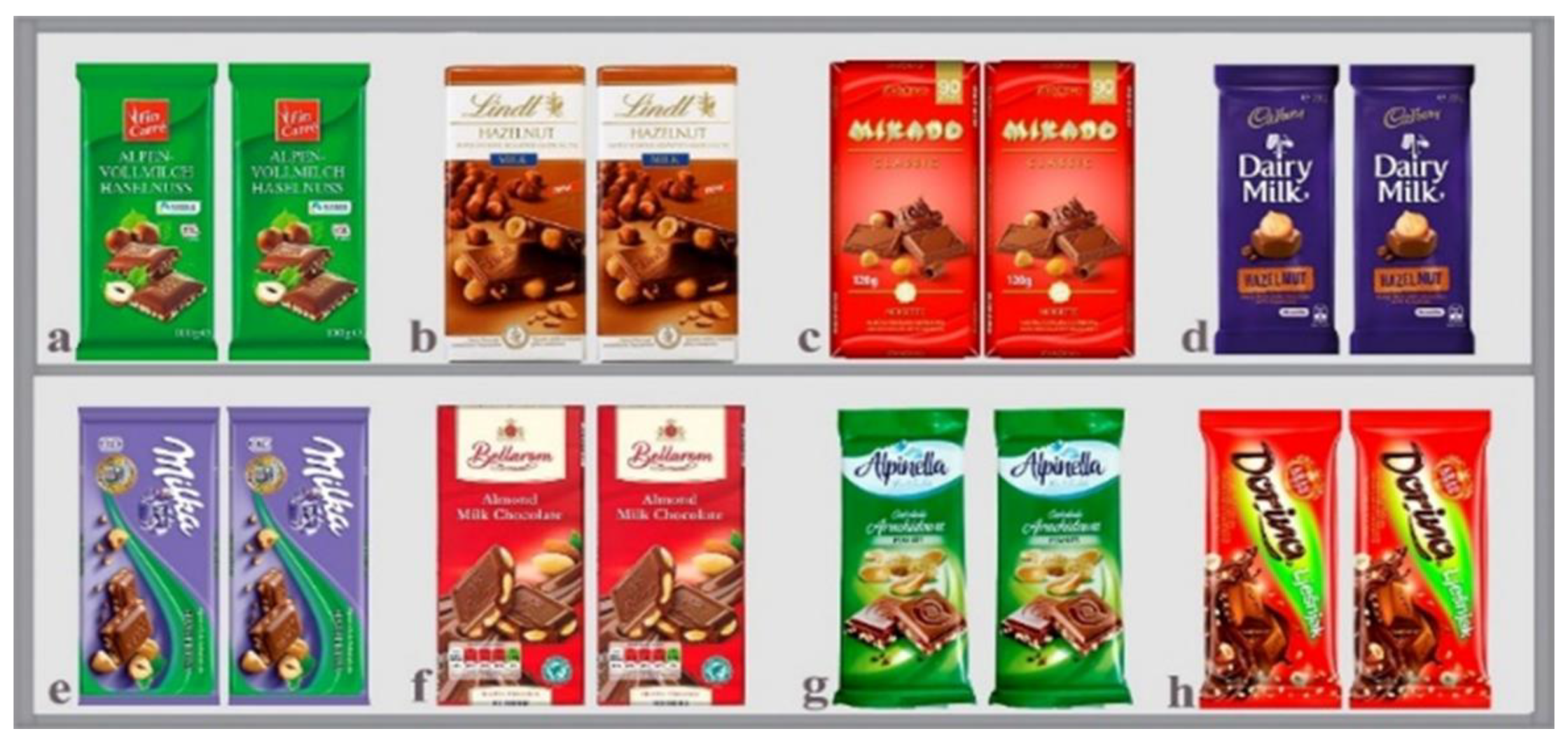
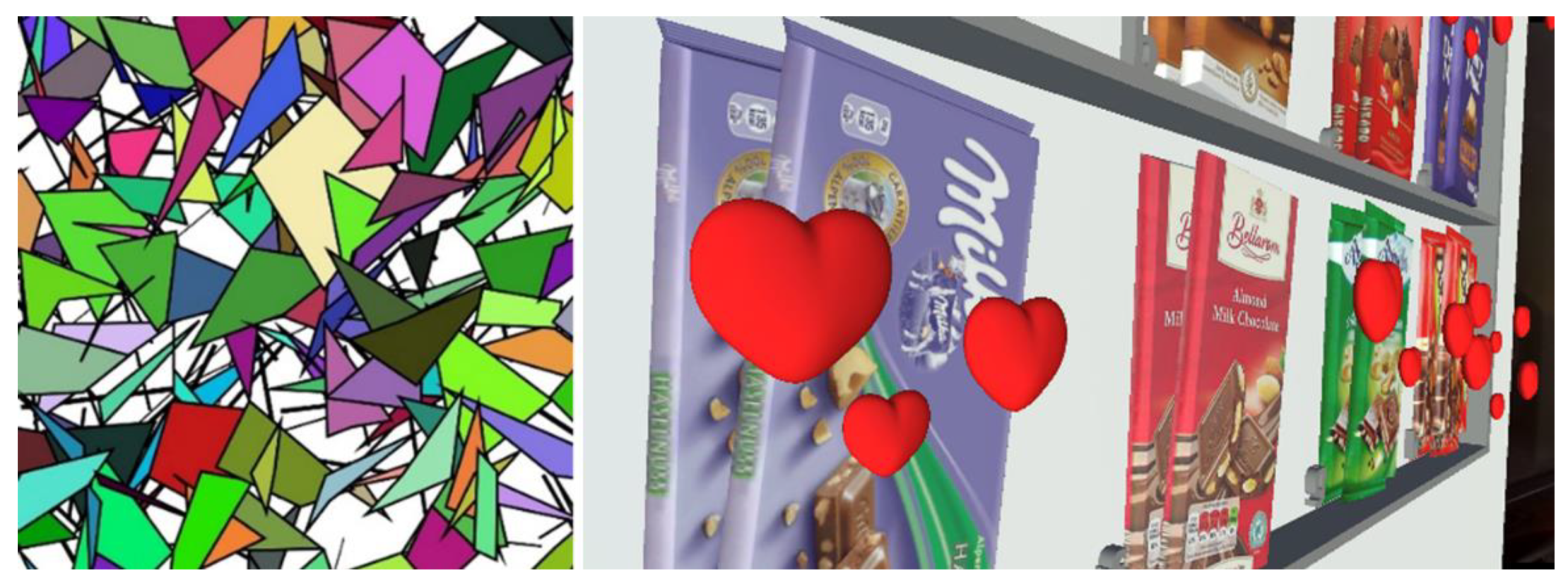
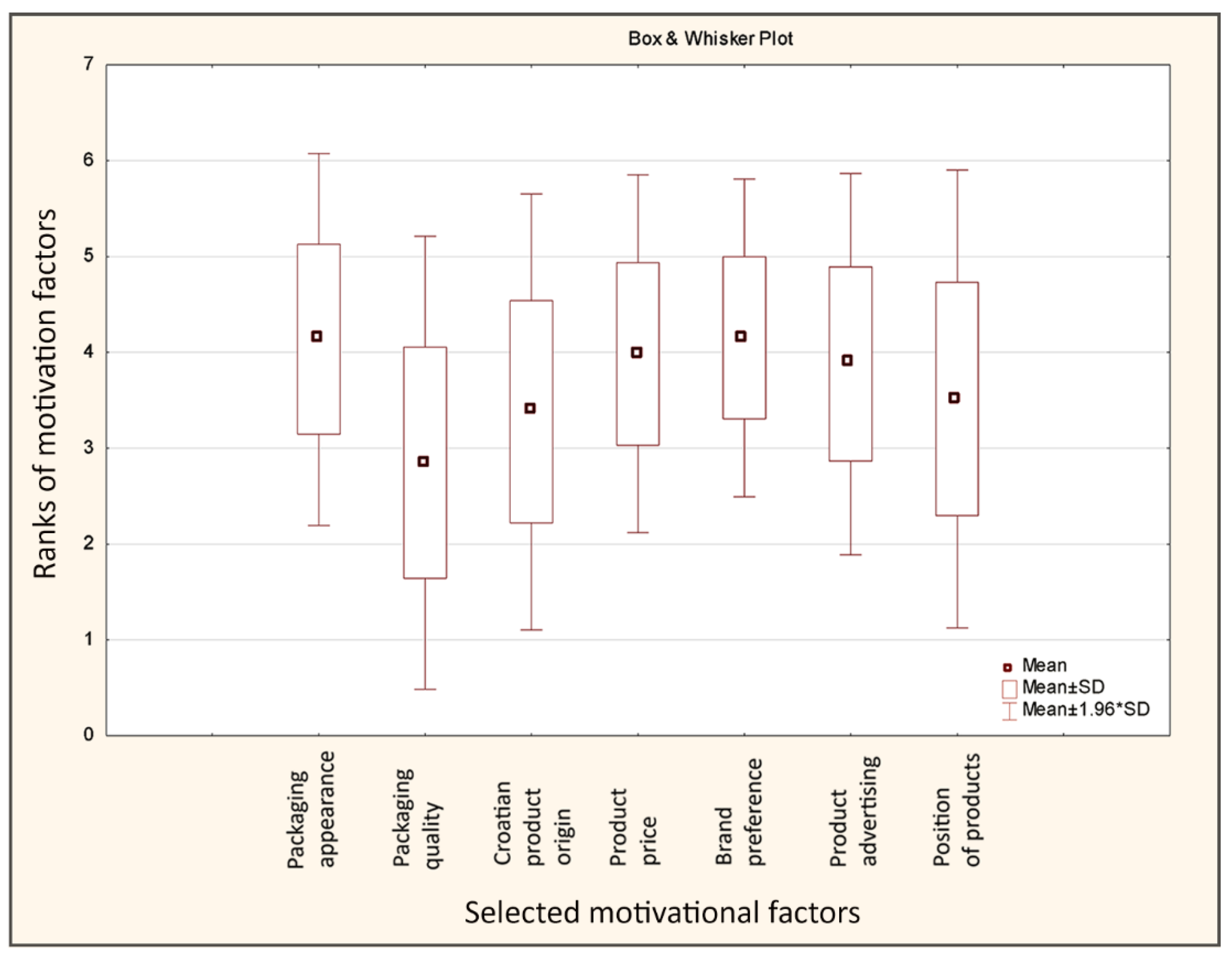
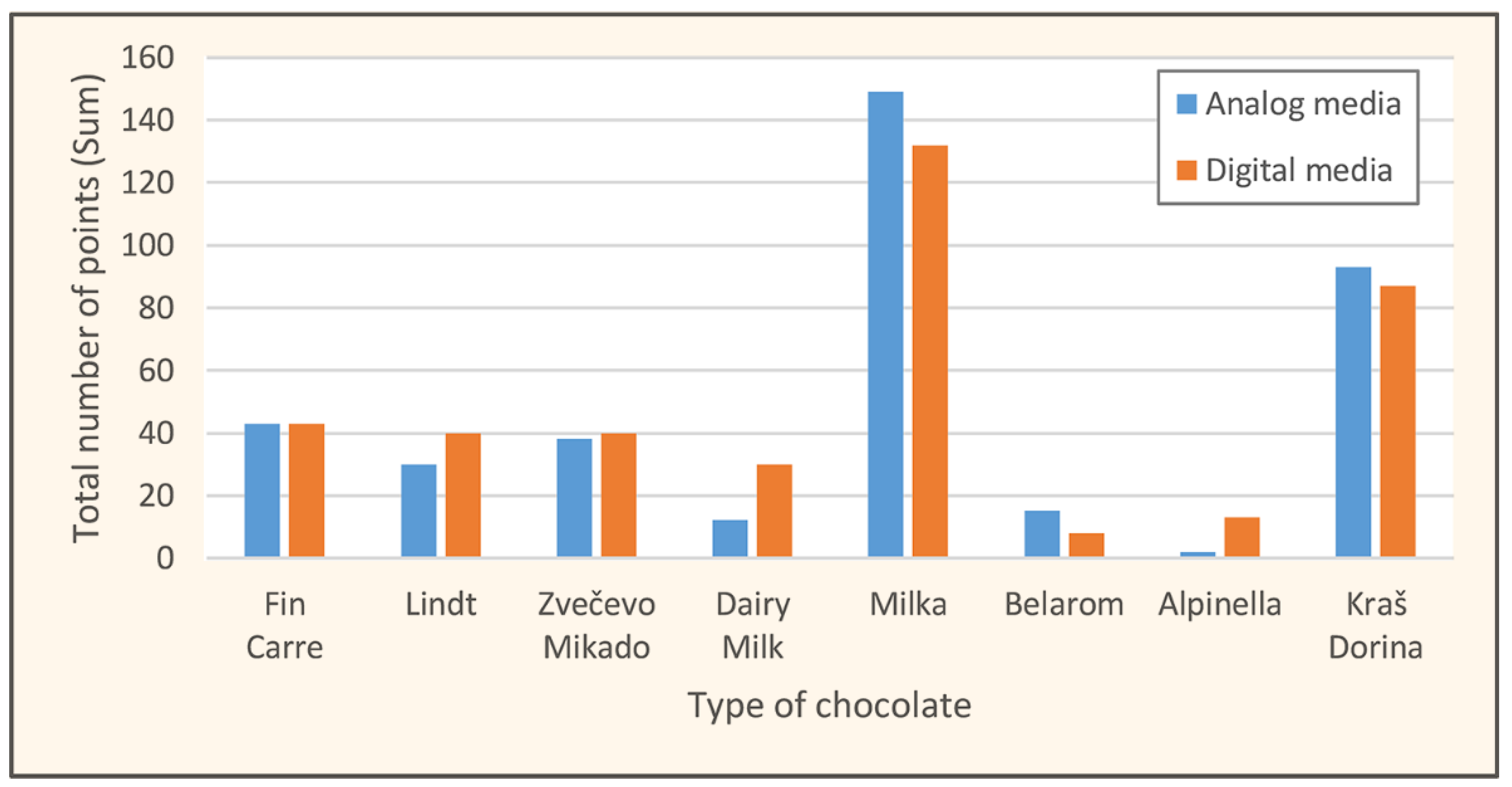
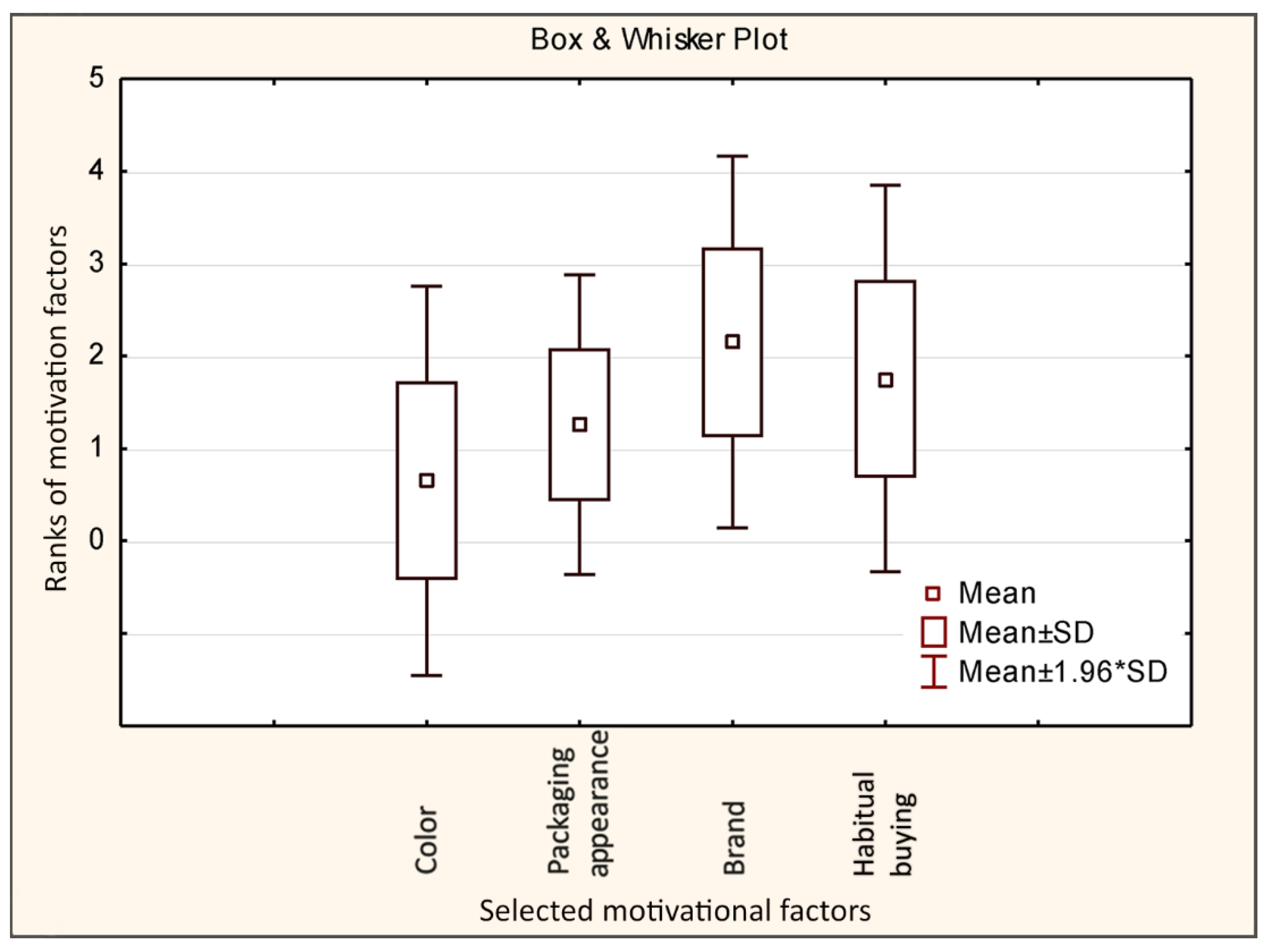
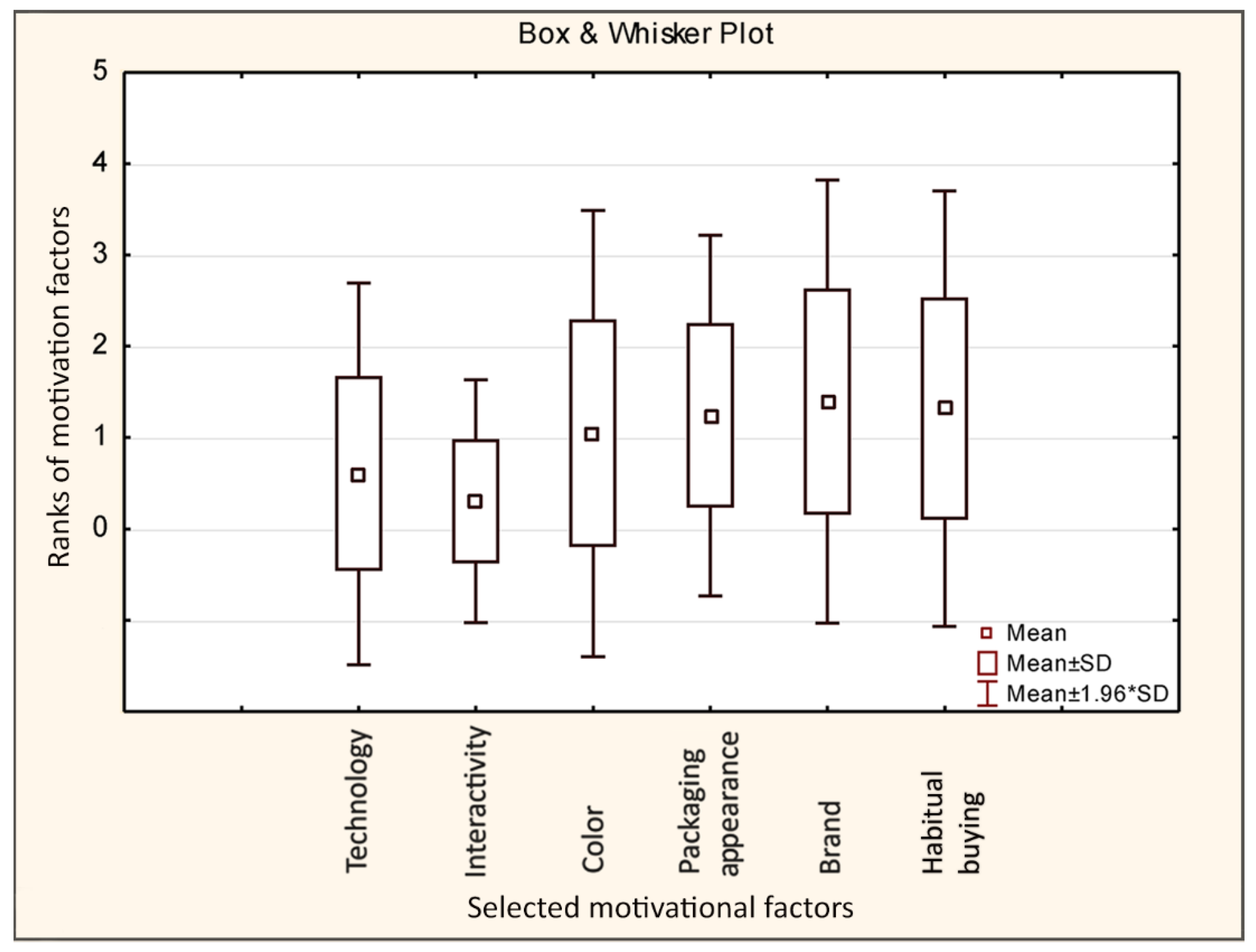
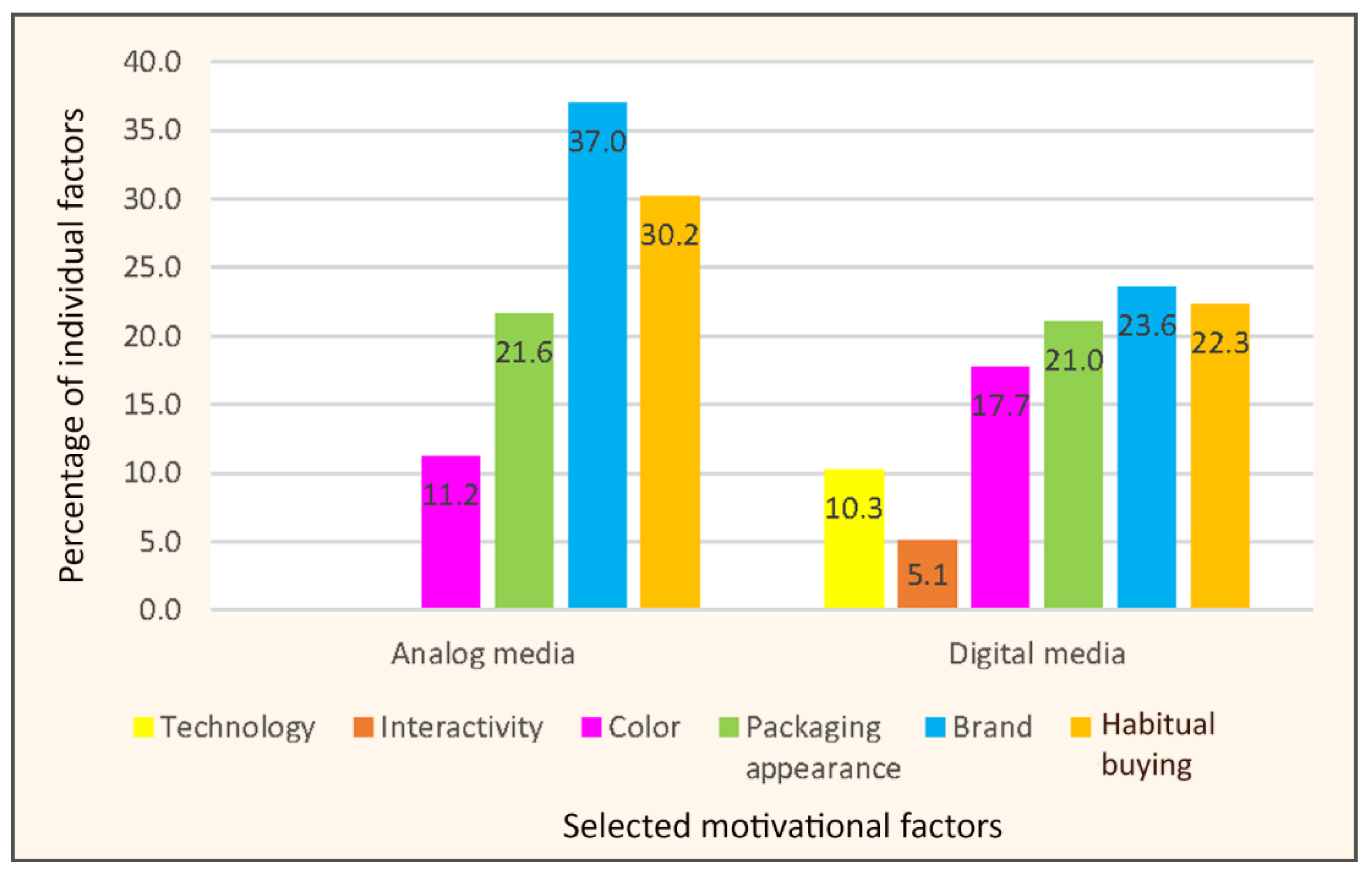
| Variable Pairs (Analog & Digital Media) | Wilcoxon-Matched Pairs Test-Marked Tests Are Significant at p < 0.050 | |||
|---|---|---|---|---|
| Valid N | T | Z | p-Value | |
| a: Fin Carre | 17 | 75.000 | 0.071 | 0.943 |
| b: Lindt | 16 | 41.500 | 1.370 | 0.170 |
| c: Zvečevo Mikado | 12 | 33.500 | 0.431 | 0.666 |
| d: Dairy Milk | 15 | 20.000 | 2.271 | 0.023 |
| e: Milka | 20 | 55.500 | 1.847 | 0.064 |
| f: Bellarom | 7 | 5.500 | 1.436 | 0.151 |
| g: Alpinella | 9 | 4.000 | 2.191 | 0.028 |
| h: Kraš Dorina | 25 | 135.500 | 0.726 | 0.467 |
| Variables (Analog/Digital Media) | Spearman Rank Order Correlations-MD Pairwise Deleted Marked Correlations Are Significant at p < 0.050 |
|---|---|
| Color | |
| Packaging appearance | |
| Brand | |
| Habitual buying |
Publisher’s Note: MDPI stays neutral with regard to jurisdictional claims in published maps and institutional affiliations. |
© 2021 by the authors. Licensee MDPI, Basel, Switzerland. This article is an open access article distributed under the terms and conditions of the Creative Commons Attribution (CC BY) license (https://creativecommons.org/licenses/by/4.0/).
Share and Cite
Valdec, D.; Bernik, A.; Hajdek, K.; Budimir, I. Comparison of the Conventional Approach and Augmented Reality on the Purchase and Selection of Food Products. Appl. Sci. 2022, 12, 218. https://doi.org/10.3390/app12010218
Valdec D, Bernik A, Hajdek K, Budimir I. Comparison of the Conventional Approach and Augmented Reality on the Purchase and Selection of Food Products. Applied Sciences. 2022; 12(1):218. https://doi.org/10.3390/app12010218
Chicago/Turabian StyleValdec, Dean, Andrija Bernik, Krunoslav Hajdek, and Ivan Budimir. 2022. "Comparison of the Conventional Approach and Augmented Reality on the Purchase and Selection of Food Products" Applied Sciences 12, no. 1: 218. https://doi.org/10.3390/app12010218
APA StyleValdec, D., Bernik, A., Hajdek, K., & Budimir, I. (2022). Comparison of the Conventional Approach and Augmented Reality on the Purchase and Selection of Food Products. Applied Sciences, 12(1), 218. https://doi.org/10.3390/app12010218






